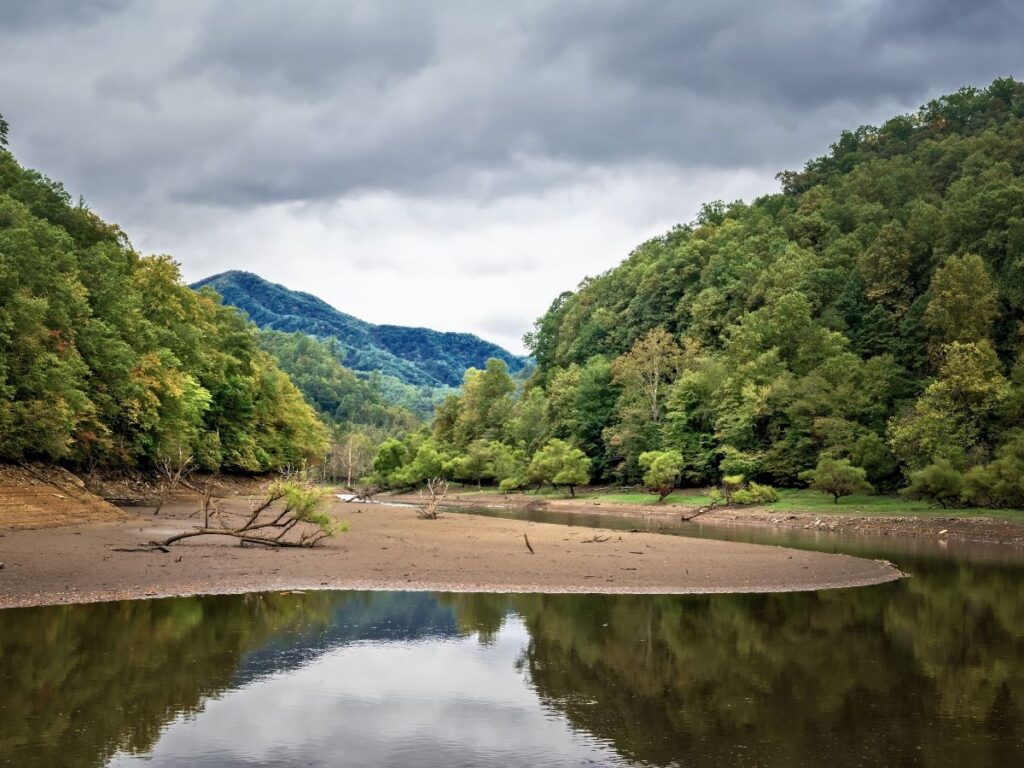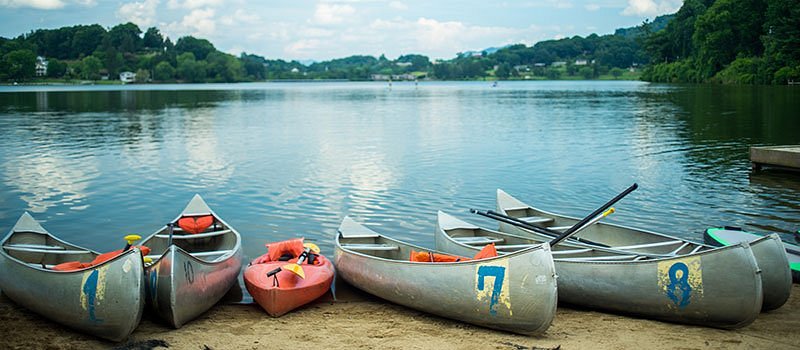North Carolina is a big state, but if you’re not from the Southeast, you might not have ever considered visiting or are even familiar with what there is to do here, Kayaking in North Carolina is a great option, from kayaking around Asheville NC (the adventure hub of the state) to exploring the tidal rivers of the Outer Banks (OBX), there are lots of different types of kayaking to enjoy.
Easy Kayaking Spots in North Carolina
Locals and out-of-state visitors have a great playground for getting in the water and appreciating the various calm waterways. Below we list a few rivers and an option for some ocean kayaking.
Roanoke River, NC
This 410-mile-long river flows through the northeastern part of North Carolina and is rich in recreational opportunities. Originally a trading route, the waterway now provides excellent fishing, paddling, and kayaking opportunities.
There are approximately 16 camping/access points along the waterway where you can launch your kayak and rest. They stretch nearly 140 miles from Weldon to the Albemarle Sound. The river flows smoothly along its entire length, making it ideal for novice kayakers.
Where to launch:
- Roanoke River Boardwalk & Boat Ramp – Skewarkee Trail, Williamston, NC 27892
The Rocky River, NC
The Rocky River Blueway begins at the Pharr Family Preserve in the Town of Midland and travels for approximately 49 miles before joining the Pee Dee River for another 19 miles to the Blewett Falls Lake Access in Lilesville, NC. This undammed blueway offers long-distance flatwater kayaking and canoeing opportunities.
While riding swift rapids, you will see scenic rock outcrops and diverse wildlife along the way. The river has several launch points, including Pharr Family Preserve, Oakboro Blueway Park I & II, and Norwood. This river, unlike most others, is not dam-controlled. As a result, good water levels can be found all year.
Where to launch:
- Pharr Family Preserve Trail – Carolina Thread Trail – 9111 Mt Pleasant Rd S, Midland, NC 28107
- Oakboro Blueway – 3615 NC-205, Oakboro, NC 28129,

Alligator River
Milltail Creek in the Alligator River National Wildlife Refuge is the best place to go if you prefer paddling in wild, remote places. The creek offers nearly 10 miles of roundtrip kayaking through marshes and woods. It is well-known for its abundance of wildlife.
Kayakers can explore the salty waterways that run throughout the refuge on the Milltail Creek Canoe and Kayak trail. This trail, located at the southern end of Buffalo City Road, splits into four separate routes totaling 15 miles. Easy-to-see markers are placed along all four trails to guide visitors through the refuge’s deep yet desolate waterways.
Where to launch:
- Alligator River National Wildlife Refuge – Miltail Rd, East Lake, NC 27953
Wrightsville Beach, NC
Wrightsville Beach is famous for its clear blue waters, which are ideal for most kayakers. The town is located directly on the Atlantic. As a result, you can rent a kayak from a variety of businesses, including Wrightsville SUP, Wrightsville Kayak Company, and Wrightsville Beach Kayak Company.
When it comes to launching a kayak or canoe in the Wrightsville Beach area, paddlers have a variety of options. The waves on this stretch of the ocean are generally calm. Kayaking is thus ideal for beginners, but this may change. Always be wary.
*SUP friendly
Where to launch:
- Wrightsville Beach – 109 Causeway Dr Wrightsville, NC 28480
Difficult and Technical Kayaking in North Carolina
There are numerous opportunities for open sea kayaking but we outline that in another post specific to Outer Banks kayaking options. Inland there are gushing rivers that give strong currents and tons of whitewater rapids that are class V+. There are a lot of rafting options in North Carolina too!
Nantahala River, NC
The Nantahala River runs through the western part of North Carolina (south of Bryson City). The most popular is in the upper section of the river, where the water current is moderate and the waves are consistent.
The Nantahala, with its perfect combination of exciting whitewater and calm pools, is an excellent introduction to the sport of whitewater paddling. It’s a “family” river with Class II and III rapids, making it suitable for seniors and children. American Whitewater and Duke Energy open the tainter gates on the Nantahala dam several times each summer, transforming the Upper Nantahala into a world-class whitewater river with Class III+, IV, and V rapids. As a result, the best months to kayak here are from April to October.
Where to launch:
- Nantahala River Launch Site – Wayah Rd, Topton, NC 28781

Cheoah River, NC
The Cheoah River is a 20-mile-long river in North Carolina’s extreme southwest corner, near Robbinsville. The Cheoah is among the most physically challenging rivers in the world, offering an excellent adventure for the most daring paddlers. There are numerous boulder fields and a 12-foot cascade along this stretch of class IV and V rapids.
The Tennessee Valley Authority, on the other hand, controls the river’s flow. Depending on the season, you may encounter different rapids. However, the TVA makes the water-release dates public so you may plan beforehand.
Where to launch:
- Nantahala Bikeway – 8185 Tapoco Rd, Robbinsville, NC 28771

Green River, Saluda
For kayakers who enjoy the rush of rapids, the Green River in Saluda is a great place to paddle. Divided into three sections – The upper Green, The “Narrows” section, and the lower Green. The Lower Green, which has a six-mile length of class II rapids, attracts the majority of visitors. On the Upper Green, you can go on a guided inflatable kayak excursion for a thrilling four-mile ride through class II to IV rapids (plus a 3/4-mile climb carrying your stuff). The Narrows, with its tremendous class V rapids, attracts hard-core expert kayakers.
Where to launch:
- The Upper Green Put-In – 58 Co Rd 1836, Flat Rock, NC 28731
Cape Fear River in Raleigh
The Cape Fear River Trail begins in J. Bayard Clark Park in Fayetteville and continues all the way to the river’s mouth in Southport. The trail winds through dense woodlands before emerging in the coastal areas. Because of the tide, the lower stretch of the river between Wilmington to Southport becomes rough. Although the river’s inlet becomes busier as boat traffic increases, it is broad enough to allow you to maneuver around the large boats. Every 10 miles, there are usually campgrounds and access sites. The river has several kilometers of flat water, followed by multiple Class III rapids depending on the water level.
Where to launch:
- River Road Park – 6500 River Rd, Wilmington, NC 28412
National / State Park Kayaking Spots near North Carolina
Located in the heart of the Appalachian Mountain range and bordering the Atlantic Ocean there’s a variety of difficult paddling that requires some experience. Check out barrier islands, swamplands, or National Wild and Scenic Rivers.
Hammocks Beach State Park
Bear Island, is a 4-mile-long unspoiled barrier island accessible by the Hammocks Beach State Park’s passenger ferry or private boat, or by paddling a canoe or kayak. The park’s mainland entrance has a full-service visitor center and serves as the launch point for ferry service, canoes, and kayaks.
Where to launch:
- Hammocks Beach State Park – 1572 State Rd 1511, Swansboro, NC 28584
Merchants Millpond State Park
Merchants Mill Pond is located in the North Carolina Merchants Millpond State Park, on the border of North Carolina and Virginia. The park features a system of different colored buoys to help you avoid getting lost in the swamp’s “maze” and to guide you to the campsites.
Kayak Merchants Millpond is a rare natural coastal swamp ecosystem in North Carolina that has remained almost untouched over millions of years. Huge Cypress and Gum trees covered in Spanish Moss provide a stunning shade over the black waters. Be on the lookout for beavers, owls, native birds, otters, deer, and the park’s most elusive resident, the American Alligator.
Where to launch:
- Merchants Millpond Boat Ramp – Mill Pond Rd, Sunbury, NC 27979
Lake Norman State Park
Lake Norman State Park is located on the coast of North Carolina’s largest artificial lake, with a boat launch and swimming beach offering convenient access to the water. If you have your own kayak or stand-up paddleboard (SUP), you can launch from the park shoreline and paddle through the park on Hicks Creek’s tranquil nooks and crannies. The creek is great for beginners, families, and SUPers looking for a leisurely paddle. You can also launch from the park boat ramp and paddle along various streams that flow into the lake.
Other activities to try besides boating include hiking, biking, fishing, camping, picnicking, and swimming.
Where to launch:
- Lake Norman State Park Boat Ramp – Boat Launch Dr, Statesville, NC 28677
New River State Park
The New River was recognized as a National Wild and Scenic River in 1976, and it flows through some of North Carolina’s most beautiful mountain vistas. The New River State Park serves as a base camp for river exploration at two main points: Wagoner Road access and US 221 access.
The New River is a perfect canoe trail for beginning paddlers due to its easy paddling and magnificent surroundings. Its calm rapids and shallow waters are ideal for novices, families, and groups. Paddling, camping, fishing, picnics, and wildlife viewing are all simple activities to combine.
Where to launch:
- New River State Park – 221 Access – New River State Park Rd, Laurel Springs, NC 28644
Recommended Kayaking Tours in North Carolina
The Alligator River National Wildlife Refuge takes visitors back in time to the prohibition era, when it was a timber and alcohol-producing area. With a guide, you’ll be able to identify many of the animals that may be seen all around you. Book the Alligator River Kayak Adventure tour here.
Birders will enjoy the Nags Head Kayak Tour. Bring your binoculars and spot bald eagles, osprey, herons, pelicans and many others that pass through or reside in the Cape Hatteras National Seashore area. Similar tours are available in Kitty Hawk and Corolla NC.
Need to Know for North Carolina
North Carolina is a well-known tourist destination for those of us that live in the Southeast for a variety of reasons. Some people are drawn to the state’s natural beauty, which includes the Appalachian Mountains (we don’t have mountains in Florida, so these are our closest) and the Outer Banks. Others come for the culture, including the many historic sites and museums. And of course, there’s also the food, which ranges from traditional Southern dishes to more contemporary offerings. No matter what brings you to North Carolina, you’re sure to find something to enjoy!
Famous food in North Carolina include barbecue, which is a style of cooking that originated in the state. North Carolina is also known for its seafood, especially its shrimp and crab. And don’t forget about the state’s famous sweet tea!
When it comes to culture, North Carolina has a lot to offer. There are many museums and historic sites, including the Wright Brothers National Memorial and the American Swedish Institute. The state is also home to a thriving arts scene, with many galleries and performance venues.
And of course, no visit to North Carolina would be complete without spending some time outdoors. The Appalachian Mountains offer beautiful views and plenty of opportunities for hiking and camping. The Outer Banks are perfect for a beach vacation, with miles of sandy beaches to relax on.
When to Visit North Carolina
North Carolina is best visited between early April and mid-June, and from early September to early November. North Carolina has four different seasons (vs us in Florida), with the spring season lasting from March to May.
The days in North Carolina are the longest in July, so if you want to view the sights during the day when the sun is up the longest, visit around that time of year. Avoid visiting North Carolina in August if you want to keep dry — it’s the wettest month of the year. Also, keep in mind that North Carolina is subject to the Atlantic Hurricane Season which is June through November. Although NC doesn’t get hit every year, it has got some bad storms in the past, so summer travelers should pay attention to the forecasts.
Weather in North Carolina
North Carolina’s average temperatures vary widely. Temperatures feel pretty great most of the year, but scorching in the summer and chilly in the winter, with a very low possibility of rain or snow all year. In comparison to other tourist sites, the area is rather temperate.
April is the driest month of the year. July is the warmest month in North Carolina, with an average high temperature of 89°F (32°C). May is the sunniest month, and my favorite!
If you’re looking for an outdoor adventure, North Carolina is a great place to kayak. With over 2,000 miles of waterways, kayakers can explore everything from the rushing rapids of the Appalachian Mountains to the placid waters of the Outer Banks. No matter what your experience level or where your interests lie, there’s something for everyone in North Carolina.




